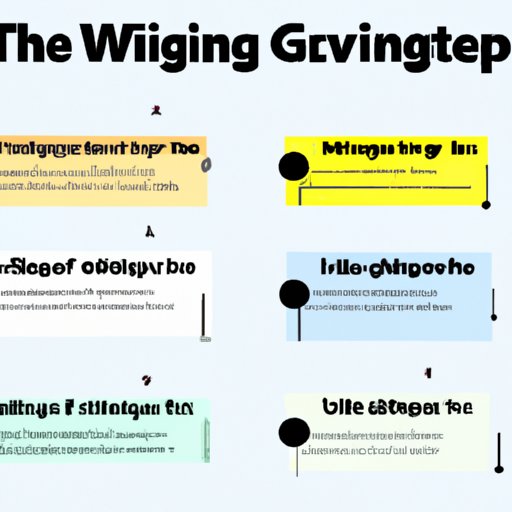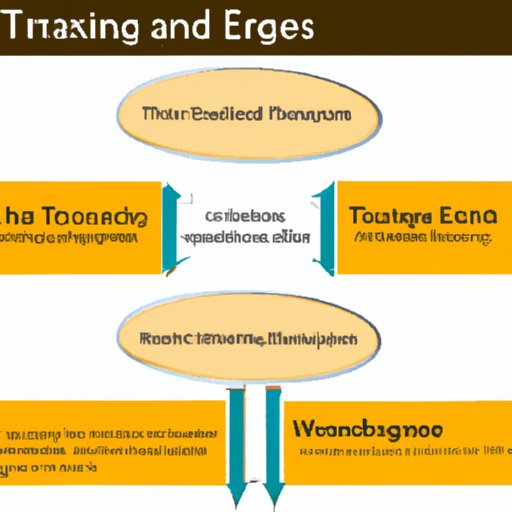Introduction
Writing is a fundamental skill that is essential to success in both academic and professional settings. As such, it is important to equip students with the knowledge and skills necessary to write effectively. Teaching the writing process can be a challenge, but there are several strategies that can help to make the process easier and more enjoyable for both teachers and students. This article will provide an overview of the different stages of the writing process, as well as examples of effective writing techniques, tips for proofreading, and more.

Outlining the Different Stages of the Writing Process
The writing process typically consists of five distinct stages: pre-writing, drafting, revising, editing, and proofreading. Each stage serves a specific purpose and should be addressed in order to produce an effective final product.
Pre-writing
The pre-writing stage involves brainstorming, researching, and organizing ideas. During this stage, students should identify their main idea or topic and develop an outline. This will help them to organize their thoughts and create an effective structure for their paper.
Drafting
During the drafting stage, students should begin to write their paper. This is when they should focus on developing their argument and making sure that their points are clear and concise. It is important to remind students that this is just a rough draft and that changes can still be made during the revision stage.
Revising
The revising stage is when students should read through their paper and make any necessary adjustments. This includes restructuring sentences, rephrasing ideas, and adding or deleting information. The goal of this stage is to ensure that the paper flows logically and that all points are supported by evidence.
Editing
The editing stage is when students should check for any errors in grammar, punctuation, spelling, and syntax. This is also the time to make sure that the paper follows the correct formatting guidelines and that all sources are properly cited.
Proofreading
The proofreading stage is the last step before submitting the paper. During this stage, students should read through the paper one last time to make sure that all errors have been corrected and that the paper is free of any typos or other mistakes. This is also the time to double-check that all sources are properly cited.
Examples of Effective Writing Techniques
In order to help students become better writers, it is important to introduce them to a variety of writing techniques. Below are some examples of effective writing techniques that can be used to help students develop their skills.
Brainstorming
Brainstorming is a great way to generate ideas and get students’ creative juices flowing. Students can either work individually or in groups to come up with ideas for their paper. This technique can be especially useful for those who may be struggling with coming up with a topic or developing an argument.
Freewriting
Freewriting is another useful technique for generating ideas. In this exercise, students are encouraged to write freely without worrying about grammar, punctuation, or structure. This can be a helpful way to get started on a paper or to overcome writer’s block.
Mind Mapping
Mind mapping is a visual tool that can be used to brainstorm and organize ideas. It involves creating a diagram with the main idea at the center and connecting related ideas with lines. This technique can be used to help students plan their paper and create an effective structure.
Outlining
Outlining is another useful tool for organizing ideas and developing an argument. Students should begin by creating an outline of their main ideas and then fill in the details. This technique can help to ensure that the paper is well-structured and that all points are supported by evidence.
Developing a Thesis Statement
A thesis statement is a sentence that summarizes the main point of a paper. It is important to teach students how to write an effective thesis statement since this is the foundation of any good paper. Here are some tips for helping students develop a strong thesis statement.
Defining a Thesis Statement
Before students can begin writing their thesis statement, it is important to explain what a thesis statement is and why it is important. Students should understand that a thesis statement is the main argument of a paper and should be clear and concise.
Identifying the Main Idea
Once students understand what a thesis statement is, they should be able to identify the main idea of their paper. This will help them to focus their argument and create a thesis statement that accurately reflects the main point of the paper.
Supporting Evidence
It is also important to teach students how to support their argument with evidence. This could include facts, statistics, quotes, personal experiences, or research findings. Encouraging students to provide evidence for their arguments will help them to create a more convincing and compelling thesis statement.
Structuring an Essay
After the thesis statement has been developed, students should begin structuring their paper. An essay typically consists of an introduction, body paragraphs, and a conclusion. Each section should have a specific purpose and should flow logically from one to the next.
Introduction
The introduction should provide an overview of the main points of the paper and should end with the thesis statement. This is the first impression that readers will have of the paper and should be clear and engaging.
Body Paragraphs
The body paragraphs should provide evidence to support the thesis statement. Each paragraph should have a main point that is supported by evidence. This is the most important part of the paper and should be well-developed and comprehensive.
Conclusion
The conclusion should summarize the main points of the paper and restate the thesis statement. It should also provide a call to action or suggest further steps that can be taken to address the issue. This is the last chance to make an impact on the reader, so it is important to make it count.

Editing and Revising a Paper
Editing and revising a paper is an important step in the writing process. This is when students should read through their paper and make any necessary changes. Encourage students to read their paper out loud to help them identify areas that need improvement. This could include restructuring sentences, rephrasing ideas, and adding or deleting information.
Researching a Topic
Research is an important part of the writing process. Students should be taught how to find credible sources and synthesize information in order to develop an argument. Encourage students to use a variety of sources, such as books, articles, and websites, to ensure that their paper is well-researched and accurate.

Tips for Proofreading and Grammar Checking
Proofreading is the last step before submitting a paper. It is important to remind students that proofreading is not just about finding typos, but also about checking for accuracy. Encourage students to read their paper out loud, use spellcheck, and utilize grammar checkers to ensure that their paper is free of any errors.
Conclusion
Teaching the writing process can be a challenging but rewarding experience. By introducing students to a variety of writing techniques and encouraging them to practice their skills, you can help them become better writers. This article has provided an overview of the five stages of the writing process, examples of effective writing techniques, tips for proofreading, and more. With these tools, you can help your students become confident and successful writers.
(Note: Is this article not meeting your expectations? Do you have knowledge or insights to share? Unlock new opportunities and expand your reach by joining our authors team. Click Registration to join us and share your expertise with our readers.)
